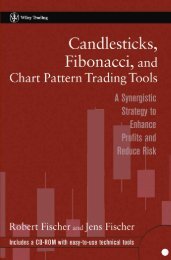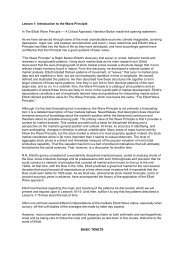The Ultimate Technical Analysis Handbook - Tradingportalen.com
The Ultimate Technical Analysis Handbook - Tradingportalen.com
The Ultimate Technical Analysis Handbook - Tradingportalen.com
You also want an ePaper? Increase the reach of your titles
YUMPU automatically turns print PDFs into web optimized ePapers that Google loves.
Chapter 4 — Origins and Applications of the Fibonacci Sequence<br />
From Fibonacci to Elliott<br />
You can tell that a trendy word<br />
or phrase has reached “buzzword”<br />
status when it is more<br />
often used to impress than to<br />
explain. A few years ago, the<br />
buzzword I heard most often<br />
was “win-win,” a concept<br />
popularized by Stephen Covey.<br />
<strong>Technical</strong> analysts, in recent<br />
years, have unfortunately elevated<br />
“Fibonacci” to the same<br />
level. A better understanding<br />
of Fibonacci may not save the<br />
term from buzzword status, but<br />
it will provide some insight to<br />
its popularity.<br />
Figure 26<br />
Leonardo Fibonacci da Pisa<br />
was a thirteenth-century mathematician<br />
who posed a question:<br />
How many pairs of rabbits<br />
placed in an enclosed area can<br />
be produced in a single year<br />
from one pair of rabbits, if each<br />
gives birth to a new pair each<br />
month starting with the second<br />
month? <strong>The</strong> answer: 144.<br />
<strong>The</strong> genius of this simple little<br />
question is not found in the<br />
answer, but in the pattern of<br />
Figure 27<br />
numbers that leads to the answer:<br />
1, 1, 2, 3, 5, 8, 13, 21, 34,<br />
55, 89, and 144. This sequence of numbers represents the propagation of rabbits during the 12-month period<br />
and is referred to as the Fibonacci sequence.<br />
<strong>The</strong> ratio between consecutive numbers in this set approaches the popular .618 and 1.618, the Fibonacci ratio<br />
and its inverse. (Relating non-consecutive numbers in the set yields other popular ratios - .146, .236, .382,<br />
.618, 1.000, 1.618, 2.618, 4.236, 6.854....)<br />
Since Leonardo Fibonacci first contemplated the mating habits of our furry little friends, the relevance of this<br />
ratio has been proven time and time again. From the DNA strand to the galaxy we live in, the Fibonacci ratio<br />
is present, defining the natural progression of growth and decay. One simple example is the human hand,<br />
<strong>com</strong>prised of five fingers with each finger consisting of three bones.<br />
<strong>The</strong> <strong>Ultimate</strong> <strong>Technical</strong> <strong>Analysis</strong> <strong>Handbook</strong> — © 2009 Elliott Wave International<br />
This ebook includes handpicked lessons from more than 200 pages of EWI’s <strong>com</strong>prehensive<br />
Trader’s Classroom Collection of eBooks. Learn more here: http://www.elliottwave.<strong>com</strong>/wave/ClubTCC<br />
19





